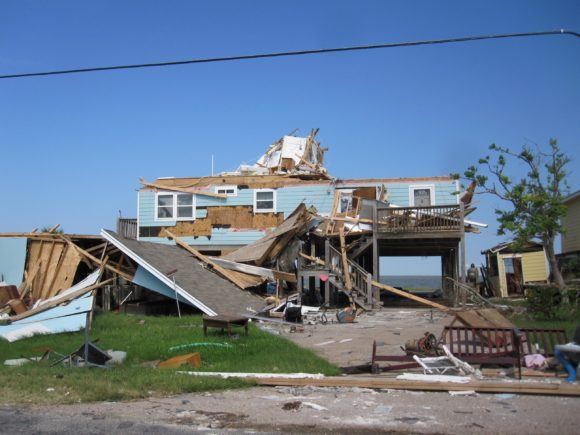Compared with 2017, last year’s hurricane season was a relatively quiet one for the Gulf Coast states of Louisiana and Texas, with major U.S. storm systems such as Hurricanes Michael and Florence staying well to the east, impacting Florida and the Carolinas. Michael struck the Florida panhandle as a Category 4 storm and Florence brought catastrophic flooding to parts of North and South Carolina.
The same can’t be said for 2017, due to Hurricane Harvey, which hit the Texas coast in late August that year. As a whole, the U.S. 2017 hurricane season was record-breaking, according to the Insurance Information Institute (I.I.I.), which notes that “17 tropical storms formed in the Atlantic Basin, with 10 of these becoming hurricanes. Six hurricanes became major storms, Category 3 and above — Harvey, Irma, Jose, Lee, Maria and Ophelia.”
Harvey made landfall as a Cat 4 hurricane near Rockport, Texas, where its 130 mile per hour winds caused extensive damage. As it moved eastward along the coast toward Louisiana, the storm produced large areas of extreme rainfall amounts that caused historic flooding in Houston and surrounding areas.
“More than 30 inches of rainfall fell on 6.9 million people, while 1.25 million experienced over 45 inches and 11,000 had over 50 inches, based on 7-day rainfall totals ending August 31. This historic U.S. rainfall caused massive flooding that displaced over 30,000 people and damaged or destroyed over 200,000 homes and businesses,” according to the NOAA National Centers for Environmental Information. Total damage costs resulting from Hurricane Harvey are estimated at more than $125 billion; the storm was responsible for 89 deaths, NOAA said.
Homes, vehicles and businesses in more than 50 Texas counties were swamped by Harvey’s catastrophic flooding, according to the Insurance Council of Texas. An estimated 250,000 vehicles were flooded; insured auto losses rose to $3.5 billion, ICT reported.
The I.I.I. pegged Harvey’s total insured losses at an estimated $16 billion and $19 billion (not counting flood losses covered by the National Flood Insurance Program), making it the fifth costliest hurricane to hit the US.
TWIA
In its annual report dated May 31, 2019, the Texas Windstorm Insurance Association (TWIA) reported that it has paid out a total $1.25 billion payments to policyholders as a result of Hurricane Harvey. TWIA is the property insurer of last resort for wind and hail in Texas coastal counties. The association said that as of April 30 of this year 2% of the 76,600 claims from Harvey remained opened.
TWIA noted that the number of complaints and claim disputes from Harvey has been low, especially compared with the association’s experience after Hurricane Ike in 2008. “Claims complaint and dispute ratios from Hurricane Harvey remain extremely low at 0.38% and 5.4% of claims. In contrast, TWIA’s claim dispute ratio from Hurricane Ike was more than 11% with the disputes largely composed of lawsuits; lawsuits from Hurricane Harvey amount to less than 1% of claims,” TWIA reported.
The association said that it has $4.2 billion in available funds as this year’s hurricane season gets underway.
Aransas County
While Houston, Southeast Texas and Southwest Louisiana bore the brunt of Hurricane Harvey’s historic and unprecedented flooding, the small coastal towns near where the storm made landfall in Aransas County in late August 2017 were devastated by Harvey’s hurricane force winds.
Nearly two years later, communities like Rockport, Fulton and Port Aransas have made headway but full recovery remains elusive.
Most retailers in the popular beach town of Port Aransas have reopened, according to media reports. But lodging still lags in the community, which is heavily dependent on tourism.
The Associated Press reported 90% of Port Aransas restaurants and retailers have reopened, but only 60% of the lodging has returned.
The Aransas County Long Term Recovery Plan notes that Harvey was the first Cat 4 hurricane to make landfall in the county. Residential damage in Aransas County ultimately totaled around $812 million and business losses came in at around $134 million.
According to a March 2019 survey of businesses conducted by the Rockport-Fulton Chamber of Commerce, most county businesses suffered extensive property damage from Harvey and 10 percent were nearly destroyed.
Only about one in four businesses had a recovery plan pre-Harvey and more than half don’t have one today, the survey found.
At the time of the survey, more than 93 percent of Harvey-impacted businesses had reopened. However, most businesses reported they continue to struggle with falling sales, fewer customers and staffing challenges.
Most respondents believe it will be 2021 before they experience full recovery, the survey found.
Legislative Harvey Response
With Harvey’s historic and unprecedented flooding in mind, the Texas Legislature this year passed, and Gov. Greg Abbott signed, a package of legislation aimed at improving the state’s response to natural disasters and creating a framework for mitigating flooding events that might occur in the future.
According to an announcement released by the governor’s office, the catastrophe response legislation includes:
“House Bill 5 (Phelan, Kolkhorst) requires the Texas Division of Emergency Management (TDEM) to develop a catastrophic debris management plan and training and establishes a work group to make recommendations on how local governments and property owners’ associations can assist with recovery efforts. It also requires TDEM to develop a model contract for debris removal.
“House Bill 7 (Morrison, Huffman) requires the Office of the Governor to develop a list of waivers that could be implemented following a disaster, and requires TDEM to develop a plan to assist local communities with disaster preparation contracts for services.
“Senate Bill 6 (Kolkhorst, Morrison) requires TDEM to develop a disaster response model guide and a wet debris study group for local communities. SB 6 also creates a disaster recovery loan program within TDEM for communities that suffered significant infrastructure damage.
“Senate Bill 7 (Creighton, Phelan) establishes the framework for providing a total of $1.6 billion through the Texas Infrastructure Resilience Fund (TIRF) as matching funds available to those communities hardest hit by Hurricane Harvey, and through the Flood Infrastructure Fund for statewide infrastructure projects to mitigate future flooding events.”
2019 Hurricane Season
The first named storm of the 2019 U.S. Atlantic hurricane season — Andrea — formed in the North Atlantic on May 20, well ahead of the season’s official start date of June 1.
Andrea’s formation marks the fifth consecutive year that a named storm has formed in the North Atlantic before the beginning of June, according to the National Oceanic and Atmospheric Administration (NOAA). Still, forecasts anticipate that the period will be an “average” one.
A June 4 forecast by Colorado State University atmospheric scientist Dr. Phil Klotzbach and his team shows the possibility of 14 named storms (including subtropical storm Andrea), six hurricanes, and two major hurricanes in 2019. A typical year would include 12 named storms, six hurricanes, and three major hurricanes, the forecast says.
Hurricane season runs through the end of November.
Topics Catastrophe Natural Disasters USA Texas Flood Louisiana Hurricane
Was this article valuable?
Here are more articles you may enjoy.



 Dunkin’ Cashier in Georgia, Stabbed by Rapper, Can’t Claim More Than Workers’ Comp
Dunkin’ Cashier in Georgia, Stabbed by Rapper, Can’t Claim More Than Workers’ Comp  Death of Teenager on Carnival Cruise Ship Ruled a Homicide
Death of Teenager on Carnival Cruise Ship Ruled a Homicide  Hartford: 10-Year Analysis Shows Shifts in Common, Expensive Small-Business Claims
Hartford: 10-Year Analysis Shows Shifts in Common, Expensive Small-Business Claims  State Farm Sued Over Policies Backed by Distressed Insurer PHL
State Farm Sued Over Policies Backed by Distressed Insurer PHL 

